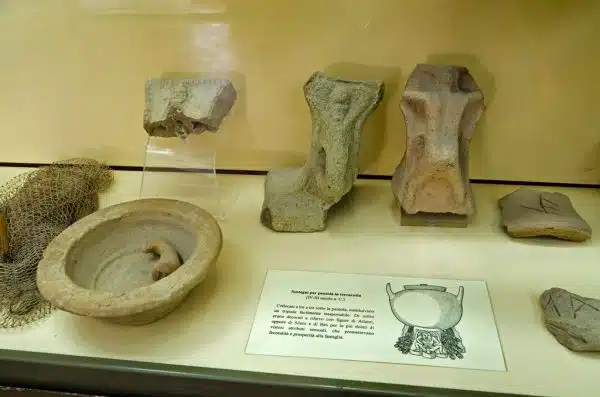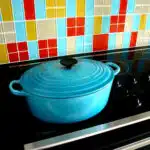Terracotta pots are a popular choice for many gardeners due to their natural and rustic appearance. However, over time these pots can accumulate dirt, algae, and other debris that not only detracts from their aesthetic appeal but also affects the health of the plants that they contain. Proper cleaning is therefore essential to maintain the beauty and functionality of terracotta pots.
In this article, we will outline four easy steps to clean terracotta pots effectively. We will cover everything from preparing the necessary materials to implementing proper techniques for scrubbing and drying the pots. By following our guidance, gardeners can ensure that their terracotta pots remain healthy and attractive for years to come.
Understanding The Importance Of Cleaning Terracotta Pots
Terracotta pots have been used for centuries due to their durability and aesthetic appeal. However, many gardeners fail to understand the importance of cleaning these pots regularly. Neglecting the maintenance and repair of these pots can lead to serious consequences such as poor plant growth, pest infestations, and soil depletion.
Regular cleaning of terracotta pots has numerous benefits for both the plants and the gardener. Firstly, it helps prevent the buildup of harmful bacteria and fungi that thrive in moist environments, which can affect plant health. Secondly, it removes mineral deposits that accumulate over time from hard water sources, preventing clogs in drainage holes. Lastly, clean pots enhance the overall appearance of a garden by eliminating unsightly stains or discoloration.
Proper maintenance and repair of terracotta pots is crucial for ensuring their longevity. Pots that are not cleaned or repaired regularly are more likely to crack or break over time due to exposure to harsh weather conditions such as frost or excessive heat. To avoid this, it is important to clean them regularly using appropriate methods and materials, as well as check for cracks or chips that may require repair before planting.
With an understanding of the importance and benefits of cleaning terracotta pots, gardeners can ensure healthy plants and maintain a visually appealing garden space. The next step is to gather the necessary materials for effectively cleaning these valuable garden assets.
Gathering The Necessary Materials
Before you begin cleaning your terracotta pots, it is important to gather all the necessary materials. You do not want to start the cleaning process only to realize that you are missing a critical tool or ingredient. Here are some things that you will need:
- A large bucket or basin
- A stiff-bristled brush or scrubbing pad
- Mild dish soap
- White vinegar
- DIY cleaning solutions or eco-friendly options
The first item on this list, a large bucket or basin, is necessary for soaking your pots. This will help loosen any dirt, grime or stains that have accumulated over time. The second item, a stiff-bristled brush or scrubbing pad, is essential for removing any remaining debris and giving your pots a deep clean. It is important to choose a brush with firm bristles so that it can effectively remove any stubborn grime.
Next on the list is mild dish soap. You may be tempted to use harsh chemicals in order to get rid of tough stains, but using mild dish soap is an effective and gentle option. White vinegar can also be used as an alternative to dish soap since it has natural cleaning properties. Lastly, consider using DIY cleaning solutions or eco-friendly options when possible. These options are not only better for the environment but also safer for you and your plants.
Now that you have gathered all of the necessary materials, it’s time to move on to the next step: emptying the pot and removing large debris. By doing this first, you’ll make sure that your pot is completely clean before soaking it in water and dish soap or vinegar solution.
Emptying The Pot And Removing Large Debris
After gathering all the necessary materials, it’s time to start cleaning your terracotta pots. The first step is to empty the pot and remove any large debris, such as dead leaves or roots. You can use a small brush or your hands to gently remove any stubborn dirt.
Removing debris from the pot is essential before proceeding with the cleaning process. Any remaining debris can hamper the effectiveness of the cleaning solution and prevent it from reaching every nook and cranny of your pot. Make sure to be thorough in removing all debris, as even small bits can accumulate over time and cause damage to your plants.
If you prefer not to use commercial cleaning solutions, there are alternatives that can be just as effective. For example, you can create a simple mixture of equal parts vinegar and water or baking soda and water. These natural solutions are gentle on the terracotta material but tough on dirt and grime.
Now that you’ve removed all large debris from your pot, it’s time to move on to soaking it in water. This step will help loosen any remaining dirt or stains before proceeding with further cleaning. By allowing the pot to soak for a few hours or overnight, you’ll ensure that every inch of its surface is ready for a thorough scrubbing in the next steps.
Soaking The Pot In Water
- Filling a terracotta pot with water is the first step in cleaning it.
- The amount of water should be enough to completely submerge the pot.
- The pot should be left to soak for a minimum of 24 hours.
- After the allotted time, the pot should be scrubbed with a soft bristled brush and a mild detergent.
- Care should be taken to ensure that the detergent used is safe for use with plants.
- After the pot is scrubbed, it should be rinsed thoroughly with clean water.
Fill The Pot With Water
Watering techniques are essential in maintaining healthy plants. One of the ways to ensure your plants thrive is by using terracotta pots. These pots are perfect for gardeners as they are porous, allowing air and moisture to pass through, which helps prevent root rot. However, over time, these pots can accumulate dirt and grime that may affect their effectiveness in watering the plants properly.
To clean terracotta pots, soaking them in water is a necessary step. To start, fill the pot with water until it reaches just below the rim. This step will help loosen any dirt or grime that has accumulated on the surface of the pot. Soaking the pot also helps prevent mineral buildup and salt residue from fertilizers, which can affect your plant’s growth.
As you soak your terracotta pot in water, you may notice some bubbles forming on its surface. This is an indication that there was still dirt left inside that needed cleaning out. Once you have finished soaking for about 30 minutes to an hour, remove the pot from the water and let it dry completely before using it again. With this simple maintenance routine, your terracotta pots will continue to provide benefits such as promoting healthy plant growth and adding aesthetic appeal to your garden for years to come!
Soaking Time Required
Effective soaking techniques are crucial in maintaining the cleanliness and functionality of terracotta pots. Aside from removing dirt and grime, soaking the pot in water helps prevent mineral buildup and salt residue that may affect plant growth. However, determining the appropriate soaking time required can maximize cleaning results.
Generally, it is recommended to soak terracotta pots for about 30 minutes to an hour. This duration allows enough time for the water to penetrate the porous surface of the pot and loosen any dirt or grime present. The length of soaking time may also depend on how dirty the pot is, but be careful not to soak it for too long as it may cause damage or discoloration.
After soaking, remove the pot from the water and let it dry completely before reusing it. Drying time may vary depending on various factors such as humidity levels, temperature, and airflow. To speed up drying, wipe off excess water using a clean cloth or towel. Once dried, your terracotta pot is ready to use again – providing excellent benefits to your plants’ health and aesthetic appeal to your garden!
Cleaning Detergent Use
Soaking terracotta pots in water is an effective way of maintaining their cleanliness and ensuring the longevity of plants. However, sometimes soaking alone may not be enough to remove stubborn stains or grime that have accumulated over time. In such cases, using cleaning detergents can help provide a deeper clean.
There are various types of cleaning detergents that one can use for terracotta pots. For those who prefer eco-friendly options, there are natural and biodegradable solutions available in the market today. These include vinegar, baking soda, and lemon juice, which are all effective in removing dirt and grime without harming the pot’s surface.
When using cleaning detergents on terracotta pots, it is essential to follow instructions carefully to avoid damaging the pot’s surface or affecting plant growth. Also, make sure to rinse the pot thoroughly with water after applying detergent to remove any residue left behind. By following these guidelines, you can achieve a clean and healthy environment for your plants while preserving the beauty of your terracotta pots.
Mixing A Cleaning Solution
To clean your terracotta pots, the first step is to create a cleaning solution. While there are many DIY cleaning solutions available, it is important to choose one that will effectively remove any dirt or stains without damaging the pot’s surface. Eco-friendly options like vinegar and baking soda can be mixed with water to create a simple yet effective solution. However, for stubborn stains or deep cleaning, commercial cleaners specifically formulated for terracotta pots may be necessary.
When creating your cleaning solution, it is important to measure out the ingredients in the correct proportions. Using too much of one ingredient can cause damage to the pot’s surface or leave behind residue that is difficult to remove. Additionally, make sure to mix the solution thoroughly before applying it to the pot. This will ensure that all ingredients are evenly distributed and will work together effectively.
Once you have your cleaning solution mixed and ready to go, it is time to move on to the next step – applying the solution to the pot. But before we get there, let’s take a closer look at some of the eco-friendly options available for cleaning terracotta pots.
- Vinegar: A natural acid that can help dissolve mineral buildup and stains.
- Baking Soda: A mild abrasive that can help scrub away dirt and grime.
- Lemon Juice: Another natural acid that can help dissolve buildup and add a fresh scent.
Applying The Solution To The Pot
Applying Solution: Techniques and Tips
Now that you have prepared the solution for cleaning your terracotta pot, it is time to apply it. Before doing so, make sure your pot is completely dry. Wet pots can prevent the solution from adhering properly and may lead to an uneven finish. Once dry, use a soft-bristled brush or sponge to apply the solution evenly over the entire surface of the pot.
When applying the solution, be sure to use gentle strokes and avoid using too much pressure as this could damage the surface of the pot. Also, ensure that you cover all areas of the pot including crevices and corners where dirt tends to accumulate. Leave the solution on for at least 30 minutes, or as directed on your cleaner’s instructions.
After leaving the solution on for a sufficient amount of time, rinse off thoroughly with water until no residue remains. Be sure to remove all traces of cleaning solution before proceeding to scrubbing the pot with a brush. Following these techniques and tips will ensure that your terracotta pot is cleaned effectively without damaging its surface.
Scrubbing The Pot With A Brush
After applying the solution to the pot, it’s time to move on to the next step. This involves scrubbing the pot with a brush to remove any stubborn dirt or stains that may be present on its surface. It is important to note that not all brushes are suitable for cleaning terracotta pots.
When selecting a brush, it’s crucial to consider the type of bristles and their stiffness. A hard-bristled brush can cause damage to the pot’s surface, while a soft-bristled one may not be effective in removing tough stains. Therefore, it’s best to opt for a medium-bristled brush that strikes a balance between effectiveness and gentleness.
Once you have chosen the right type of brush, dip it into your cleaning solution and start scrubbing the pot gently in circular motions. Take your time and ensure that every inch of the pot’s surface is covered with the cleaning solution. After you’re done scrubbing, rinse off the pot thoroughly with water until all traces of dirt and cleaning solution are removed from its surface.
Rinsing The Pot With Water
After scrubbing your terracotta pot with warm soapy water, the next step is rinsing it thoroughly with water. Using a garden hose, rinse the pot off until all of the soap residue has been removed. Make sure to also rinse the inside of the pot to remove any remaining dirt or debris.
If you prefer not to use water, vinegar can be used as an alternative. Mix equal parts of white vinegar and water in a spray bottle and generously spritz the entire surface of the pot. Let it sit for a few minutes before wiping it down with a clean cloth. This method not only rinses off any remaining soap but also disinfects the pot from any bacteria that may have accumulated.
Although water and vinegar are excellent choices for rinsing your terracotta pots, there are other alternatives such as lemon juice or hydrogen peroxide. These options work similarly to vinegar by cleaning and disinfecting your pots without using harsh chemicals or damaging its natural porous texture. Experiment with different methods and find what works best for you before moving on to removing stubborn stains in the next section.
Transition: Now that you have thoroughly rinsed your terracotta pot, it’s time to tackle those stubborn stains that just won’t come off.
Removing Stubborn Stains
- Soaking terracotta pots in soapy water is an effective first step in removing stubborn stains.
- Abrasive scrubbing can be utilized to loosen and remove dirt and grime from porous terracotta surfaces.
- Natural cleaners, such as baking soda and white vinegar, can be used to remove stains and other discolorations from terracotta pots.
- When combined with a soft cloth or brush, natural cleaners can help to break up and lift the particles, making it easier to remove them.
- Care should be taken to avoid using harsh chemicals or abrasive tools that may damage the terracotta surface.
- Following these steps will help to ensure that terracotta pots are clean and free of stubborn stains.
Soaking In Soapy Water
To effectively remove stubborn stains on terracotta pots, soaking them in soapy water is a great place to start. Begin by filling a basin or sink with warm water and adding a few drops of dish soap. Then, gently place the pots into the water and let them soak for at least 30 minutes, or until the stains begin to loosen. For particularly stubborn stains, using vinegar can be an effective alternative soaking solution.
When soaking the pots in soapy water, it’s important to use a mild dish soap that won’t damage the terracotta material. Avoid using harsh chemicals or abrasive scrubbers that could scratch or etch the surface of the pot. Additionally, be sure to rinse the pots thoroughly after soaking to remove any remaining soap residue.
If you’re looking for an alternative soaking solution, vinegar can be an effective option. Simply mix equal parts white vinegar and water in a basin or sink, and let the pots soak for at least 30 minutes. Vinegar’s acidic properties help break down tough stains and mineral buildup on terracotta surfaces. After soaking in vinegar, rinse the pots thoroughly with clean water before allowing them to dry completely.
Scrubbing With An Abrasive
Another effective way to remove stubborn stains on terracotta pots is by scrubbing them with an abrasive. This method involves using a gentle abrasive to scrub away the stains, followed by rinsing the pot thoroughly with clean water. However, when using this method, it’s important to choose an abrasive that won’t damage the terracotta material.
One alternative abrasive that can be used is baking soda. Simply mix baking soda with water to create a paste, and then use it to scrub away the stains on the terracotta pot. Baking soda is a mild abrasive that won’t scratch or etch the surface of the pot. After scrubbing with baking soda, rinse the pot thoroughly with clean water and allow it to dry completely.
Another alternative abrasive is sandpaper or a pumice stone. These abrasives are more aggressive than baking soda and should only be used on tough stains that can’t be removed by soaking or using milder abrasives. When using sandpaper or a pumice stone, be sure to use light pressure and work in small circular motions to avoid damaging the terracotta material. Rinse the pot thoroughly after scrubbing and allow it to dry completely before using it again.
Using A Natural Cleaner
Terracotta pots are a popular choice for gardeners due to their porous nature, which allows air and moisture to circulate around plant roots. However, these pots can be prone to stubborn stains that are difficult to remove. While abrasive methods can be effective, some people prefer using natural alternatives such as DIY cleaners.
One option for a natural cleaner is vinegar. To use this method, mix equal parts white vinegar and water in a spray bottle and apply it to the stained area of the pot. Allow the mixture to sit for several minutes before scrubbing with a soft-bristled brush. Rinse the pot thoroughly with clean water and repeat if necessary.
Another natural alternative is lemon juice. This acidic fruit contains citric acid, which can help break down stubborn stains on terracotta pots. Cut a lemon in half and rub it over the stained area of the pot, using light pressure to avoid scratching the surface. Allow the lemon juice to sit on the pot for several minutes before rinsing it off with clean water.
Using a natural cleaner is not only an effective way to remove stubborn stains on terracotta pots but also an eco-friendly option compared to harsh chemicals. With these DIY cleaners readily available in most households, you can easily restore your terracotta pots’ original beauty without spending too much money or harming the environment.
Drying The Pot
After the cleaning process, it is essential to dry the terracotta pot thoroughly. Air drying is the most recommended method of drying as it allows for natural evaporation of all moisture from the pot. It is also the preferred option as it reduces the risk of damaging or scratching the surface of the pot. Once cleaned, place the pot in a well-ventilated area and allow it to dry completely before proceeding with replanting.
Towel drying can be used if you are in a hurry and need to speed up the process. However, this method can leave behind fibers from the towel that may stick to and damage the surface of your terracotta pots. Therefore, use a soft cloth or paper towel when towel drying your pot.
If you are in a rush and cannot wait for air or towel drying, artificial drying methods such as using a hairdryer is an option. However, extreme caution must be exercised when using heat on any terracotta pot as they are prone to cracking under high temperatures. Natural drying methods are always best; however, if time constraints require artificial means, then ensure that you keep a safe distance between your hairdryer and terracotta pots.
- To ensure proper drying after cleaning, consider these tips:
- Always clean and dry your pots one at a time.
- Choose a sunny day for natural air-drying.
- For smaller pots, place them upside down on top of an elevated surface such as bricks or stones.
- When using artificial means for faster drying times, avoid overheating by keeping your dryer at least six inches away from your pot.
Once fully dried, you can proceed with replanting your terracotta pots without worrying about any remaining moisture causing damage to new plants. Allow sufficient time for thorough drying before proceeding with replanting so that you may enjoy healthy plants in beautiful pots!
Replanting The Pot
When it comes to replanting a terracotta pot, there are a few things to keep in mind. First and foremost, choosing the appropriate soil is crucial for the health of your plants. Terracotta pots tend to absorb moisture, so it’s important to use a well-draining soil mix that won’t become waterlogged. Look for mixes that include materials like peat moss, perlite, or vermiculite.
Once you’ve selected the soil, it’s time to choose the right plants for your pot. Consider the size of the pot and how much sunlight it will receive throughout the day. Some plants may require more space or sunlight than others, so be sure to do your research before making any decisions. Additionally, think about whether you want to create a cohesive look with similar types of plants or mix and match different varieties.
Replanting is also an opportunity to add some new elements to your pot, such as decorative rocks or plant stakes. Get creative and have fun with it! When you’re finished planting, give your new arrangement a good watering and place it in its new location. With proper care and attention, your newly replanted terracotta pot will thrive in its new home.
As you finish up replanting your terracotta pot, don’t forget about proper storage when not in use. Store pots in a cool and dry place where they won’t be exposed to extreme temperatures or direct sunlight. This will help prevent cracking and ensure that your pots are ready for their next use when the time comes.
Storing The Pot
Storing the Pot:
Proper storage of terracotta pots is essential to preserve their longevity. Begin by removing any remaining dust or debris from the pot’s surface using a soft brush or cloth. Ensure that the pot is completely dry before storing it to prevent any mold or mildew growth.
When it comes to storing tips, place the terracotta pots in a cool and dry place. Avoid areas with high humidity levels as it can cause moisture buildup, which leads to cracks or chips on the pot’s surface. Also, store the pots upside down to avoid water accumulation inside the pot’s base.
Decorative options are also available for those who want to add some flair to their pot storage display. Use shelves or racks specifically designed for plant pots and arrange them in an aesthetically pleasing manner. Additionally, consider painting your terracotta pots with vibrant colors or patterns that complement your decor style.
Having learned about proper storage techniques and decorative options, maintaining terracotta pots for longevity is crucially important. To keep your pots looking new, regular cleaning and maintenance are necessary. Read on to discover simple yet effective ways to maintain your terra cotta pots’ quality for years to come.
Maintaining Terracotta Pots For Longevity
After storing your terracotta pots properly, it’s important to take preventive measures to ensure their longevity. One of the most crucial steps is to avoid exposing them to extreme temperatures. Terracotta pots are porous and can absorb moisture, causing them to expand and contract in response to changes in temperature. This can lead to cracks or even breakage over time. Therefore, keep them away from direct sunlight and protect them from frost during winter.
Another common issue with terracotta pots is cracking. While small cracks may not seem like a big deal, they can quickly worsen and cause the pot to break apart entirely. If you notice any cracks in your pot, it’s essential to repair them as soon as possible. To do this, you’ll need a strong adhesive that can bond with the terra cotta material. Apply the adhesive along the crack and hold the pieces together until they dry completely.
While cleaning your terracotta pots with soap and water is an effective method, there are alternative cleaning methods that you might consider using for stubborn stains. One option is to use white vinegar mixed with water in equal parts. This solution is safe for both plants and pottery and will help remove any mineral buildup or discoloration on your pot’s surface. Another method involves using baking soda mixed with water into a paste-like consistency that you apply directly onto the stains before scrubbing off with a brush or sponge.
Transition: Now that we’ve discussed preventive measures and repairing cracks, let’s explore other ways of cleaning terracotta pots using alternative methods that may be useful for plant enthusiasts who want their pots looking good as new without much hassle.
Alternative Cleaning Methods
Like every other household item, terracotta pots require cleaning from time to time. While the conventional method of cleaning them involves soap and water, there are natural alternatives that can be equally effective. These homemade solutions not only remove dirt but also improve the overall quality of the pot.
One such alternative is vinegar, a common household ingredient that has been used for ages by our ancestors for various purposes. To clean your terracotta pots with vinegar, mix equal parts of vinegar and water and apply it with a soft-bristled brush. Allow it to sit for a few minutes before rinsing it off with warm water. Not only does this solution remove dirt and grime, but it also helps eliminate bacteria and fungus that may have formed on the pot.
Another natural alternative is lemon juice, which is rich in citric acid and acts as a natural bleaching agent. Simply cut a lemon in half and rub it onto the surface of the pot until stains disappear. Rinse thoroughly with warm water to remove any leftover juice or pulp. This method not only removes stains but also leaves behind a fresh citrus scent.
If you’re looking for an eco-friendly way to clean your terracotta pots, natural alternatives like vinegar and lemon juice are great options. Not only are they affordable but also free from harsh chemicals that could harm your plants or family members. By using these homemade solutions, you can maintain the quality of your terracotta pots without compromising on health or sustainability concerns. In the next section, we’ll discuss some common issues that gardeners face while maintaining their terracotta pots and how to troubleshoot them effectively.
Troubleshooting Common Issues
Terracotta pots are a beautiful and natural addition to any garden, but they can be susceptible to mold growth and discoloration over time. Fortunately, there are some common issues that can easily be addressed with a little bit of effort.
Preventing mold growth is essential for keeping your terracotta pots healthy and beautiful. One way to do this is by using a solution of one part vinegar to three parts water to clean the surface of the pot. This will help kill any existing mold spores and prevent future growth. Additionally, make sure to remove any dead plant material from the pot as soon as possible, as this can create an environment ripe for mold.
Over time, terracotta pots may lose their vibrant color and become dull or discolored. Color restoration is possible with a few simple steps. First, clean the pot thoroughly using warm water and a mild soap. Once it’s dry, apply a coat of acrylic sealer to protect the surface from further damage. Finally, use a high-quality paint designed specifically for use on terracotta pots to restore its original color.
Incorporating these preventative measures and restoration techniques into your routine garden care will ensure that your terracotta pots remain beautiful for years to come. By taking care of your garden tools and accessories like this, you’ll be able to enjoy your gardening experience even more!
- Preventing Mold
- Use one part vinegar to three parts water solution
- Remove any dead plant material promptly
- Color Restoration
- Clean thoroughly with mild soap and warm water
- Apply acrylic sealer
- Use high-quality paint made for terracotta pots – to ensure long-lasting color restoration.
Conclusion
Terracotta pots are an essential part of any gardener’s toolkit, but their porous nature means they can easily become clogged with dirt and debris over time. Cleaning your terracotta pots not only improves their appearance but also helps to prevent the spread of diseases and pests in your garden. By following these four easy steps, you can ensure your terracotta pots stay clean and healthy.
Firstly, gather all the necessary materials before emptying the pot and removing large debris. Soak the pot in water before mixing a cleaning solution and scrubbing away any stubborn stains or buildup. Finally, store the pot correctly to maintain its longevity.
Remember that regular maintenance is key to keeping your terracotta pots looking their best. Clean them at least once a year or whenever they start to look dirty. If you encounter any issues during the cleaning process, such as stubborn stains or discoloration, try alternative methods like using vinegar or bleach solutions.
In conclusion, taking care of your terracotta pots is an essential part of maintaining a healthy garden. By following these simple steps and maintaining them regularly, you can enjoy beautiful blooms and thriving plants for years to come. Don’t let dirty pots hold you back from creating a stunning outdoor space – take action today!
Image Credits
- “Mortar & pestle; terracotta cooking pot supports” by diffendale (featured)





























